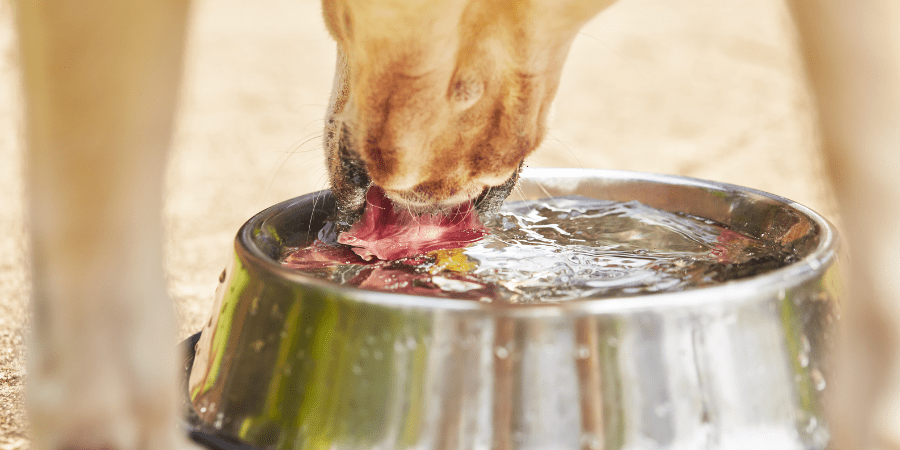Swimming is an excellent form of exercise for many dogs, especially on a hot summer’s day. But did you know that swallowing too much water in a short space of time can lead to water intoxication in dogs – a rare but potentially fatal condition?
What is water intoxication in dogs, and how does it happen?
Water intoxication happens when a dog swallows excessive amounts of water.
Owners may not realise it, but swimming or playing in water for a long time increases the risk of their dog becoming ill from water intoxication (sometimes known as water poisoning). Even water-based activities or games – such as throwing a ball or toy in a river for your dog to retrieve or playing with water from the garden hose – can cause them to swallow too much water and fall ill.
Swallowing excess water can dilute a dog’s sodium (salt) levels, leading to hyponatremia (lower-than-normal sodium levels in the bloodstream). When this happens, cells in the body try to rebalance by absorbing more water. This causes the cells to swell and increase in size.
Over time, the dog’s kidneys can usually sort out the sodium and water levels. But if a dog’s brain cells swell, it can quickly lead to irreversible brain damage before they have the chance.
What are the symptoms of water intoxication in dogs?
Thankfully, water intoxication in dogs is rare, but owners should know what symptoms to look out for.
Water intoxication can cause dogs to feel very poorly very quickly, so it’s important that owners can spot when something is wrong. The signs or changes in behaviours you should look out for in your dog (after they’ve been spending time in the water) include:
- Staggering or loss of coordination
- Tiredness
- Weakness
- Bloating
- Vomiting
- Passing large amounts of clear urine
- Dilated pupils or glazed eyes
- Excessive salivation (drooling)
In severe cases of water intoxication, a dog may have difficulty breathing, collapse, have a seizure, or fall into a coma.
When should I call my vet?
Contact your vet immediately if your dog shows any signs of water intoxication.
Your vet will want to carry out blood tests to measure your dog’s electrolyte levels. If your dog’s electrolyte levels are low and water intoxication is suspected, they will need fluids to pump electrolytes slowly back into their system. A treatment plan for water intoxication may include a diuretic (a type of medication that helps your dog pee more).
If treatment is started quickly and symptoms aren’t severe, most dogs recover from water intoxication. However, if a dog’s symptoms are severe or neurological (affecting the brain), unfortunately, water intoxication can be fatal. This is because it can be extremely difficult to rebalance their sodium levels safely.
The size of the dog and the volume of water they have swallowed will determine if they have swallowed too much.
Are certain dogs more at risk of water intoxication?
Certain dogs are more at risk of water poisoning compared to others.
For example, a large dog breed (e.g. Border Collie) could swallow more water than a small dog breed (e.g. Jack Russell Terrier) before they risk water intoxication. Simply put, small dogs may reach their limit with lower volumes of water. Nevertheless, owners should be aware that all dogs are at risk. However, how much water is too much is difficult to define as it depends on many factors.
Your dog is unlikely to voluntarily drink enough water from their bowl to cause water intoxication, so you shouldn’t restrict their water.

How can I help prevent water intoxication in dogs?
Water intoxication in dogs is a real threat, but owners shouldn’t stop dogs from swimming or playing in water.
Swimming and playing in the water are excellent forms of exercise for dogs, not to mention great fun! Doing so will help them keep active and cool when temperatures soar, so it's important that owners allow their dogs to spend time in the water safely.
- Limit the time a dog spends in water to prevent them from swallowing too much.
- Give them time to rest with regular breaks to allow the body’s natural fluid balancing system time to manage any excess intake.
- Use floating toys to help prevent your dog from diving under the water. Avoid tennis balls and other rounded toys; instead, opt for flat toys, which allow your dog to close their mouth around it tighter, hopefully avoiding excessive water intake.
- Consider training your dog to wear a flotation vest to keep them above water.
- Never leave your dog unsupervised when in water.
- Don’t restrict your dog from drinking water from their bowl. If your dog is drinking excessively, contact your vet for advice.
